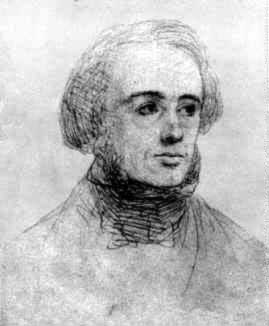James MacCullagh facts for kids
Quick facts for kids
James MacCullagh
|
|
|---|---|

James MacCullagh (1809–1847)
|
|
| Born | 1809 Landahaussy, County Tyrone, now Northern Ireland
|
| Died | 24 October 1847, Dublin, Ireland |
| Nationality | Irish |
| Known for | Theory of elasticity |
| Awards | Cunningham Medal (1838), Copley Medal (1842) |
| Scientific career | |
| Fields | Physics Mathematics |
James MacCullagh (born 1809, died 1847) was a brilliant Irish mathematician and physicist. He made important discoveries about light and how it behaves. He was known for his work on the theory of elasticity and for exploring the nature of light.
Contents
Early Life and Education
James MacCullagh was born in Landahaussy, a small place near Plumbridge in County Tyrone, Ireland. When he was about 10 years old, his family, which included twelve children, moved to Strabane. From a young age, James showed a great talent for mathematics.
In 1824, he began studying at Trinity College Dublin. He was a very bright student. He earned a special scholarship in 1827 and finished his degree in 1829.
A Career at Trinity College Dublin
After graduating, James MacCullagh became a fellow of Trinity College Dublin in 1832. This meant he was a senior member of the college. He worked at the same time as another famous Irish scientist, William Rowan Hamilton.
In 1833, MacCullagh joined the Royal Irish Academy. This is a group of leading experts in Ireland. He became a professor of mathematics at Trinity College in 1835. Later, in 1843, he became a professor of natural and experimental philosophy. This role involved teaching about physics and how experiments work.
MacCullagh was an inspiring teacher. Many of his students became famous scholars themselves. These included Samuel Haughton, Andrew Searle Hart, John Kells Ingram, and George Salmon.
Friendly Rivalries
James MacCullagh and William Rowan Hamilton were both brilliant. Sometimes, they had disagreements about who discovered something first. For example, Hamilton predicted something called "conical refraction" in 1832. MacCullagh later said he had found a similar idea in 1830. These discussions were part of how science moved forward back then.
Discoveries and Awards
MacCullagh spent most of his time studying optics, which is the science of light. He also did important work in geometry, which is the study of shapes and spaces. His most famous work on geometry, called On surfaces of the second order, was published in 1843.
He received important awards for his scientific work:
- In 1838, he won the Cunningham Medal from the Royal Irish Academy. This was for his paper on how light reflects and bends in crystals.
- In 1842, he was awarded the Copley Medal. This is a very prestigious award for his work on understanding the nature of light.
MacCullagh was also involved with the British Science Association. He exchanged letters with other important scientists of his time, like John Herschel and Charles Babbage. Charles Babbage, who invented early computers, called MacCullagh "an excellent friend." They even talked about Babbage's amazing "analytical engine."
Understanding Light and Optics
James MacCullagh's most important paper on optics was presented in 1839. It was called An essay towards a dynamical theory of crystalline reflection and refraction. In this paper, he introduced a new mathematical idea called the "curl" of a vector field. This idea helps describe how things rotate or twist. (The word 'curl' was later used by James Clerk Maxwell in 1870).
MacCullagh wanted to create a mathematical model for how light travels. He found that for light waves, which only vibrate from side to side (called transverse waves), his model needed a special kind of "potential function." This function showed that light didn't behave like waves in a simple liquid or solid. Instead, it behaved as if it was in a medium that only resisted twisting, not stretching or squeezing.
The Ether and Light
Scientists at the time believed light traveled through an invisible substance called the "luminiferous aether" (light-carrying ether). MacCullagh's ideas suggested this ether was very unusual. He admitted that no known physical material could have the properties he described. He said, "Concerning the peculiar constitution of the ether, we know nothing...". He focused on the mathematical equations that worked, even if the physical model was hard to imagine.
His theory was very successful at explaining how light behaves, including the laws discovered by Snell and Augustin-Jean Fresnel. However, many scientists found it hard to accept a theory that didn't have a clear physical model. They were used to thinking of the ether as a physical thing, like a fluid.
MacCullagh's ideas were largely forgotten for a while. But in 1880, George Francis FitzGerald rediscovered them. He realized MacCullagh's work fit well with James Clerk Maxwell's new electromagnetic theory of light. Later, William Thomson, 1st Baron Kelvin even managed to create a physical model of MacCullagh's strange ether using spinning tops (gyrostats) on a special framework.
Later Life and Legacy
James MacCullagh was a very dedicated person. He was also interested in politics and tried to get elected to represent Dublin University in 1847, but he was not successful.
He worked incredibly hard and sadly passed away in 1847 in his rooms at Trinity College Dublin. He was only 38 years old. After his death, his friend William Rowan Hamilton helped make sure MacCullagh's sisters received financial support.
In May 2009, a special plaque was placed at his family tomb in Upper Badoney. This was part of events to remember his life and contributions to science.

